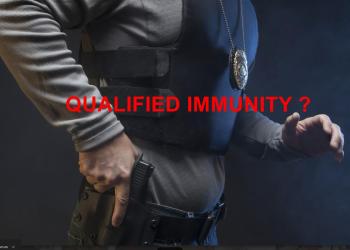
9th Circuit Affirms Qualified Immunity for Officers After Bystander Injured in Pursuit Shooting
- The Fourth Amendment and the Use of Deadly Force
- Qualified Immunity and the Use of Deadly Force
- The Seizure of a Passenger in a Stopped Motor Vehicle
Passengers in a motor vehicle stopped for violating traffic laws are in fact seized, for purposes of the Fourth Amendment. Police officers who injure an innocent bystander when returning fire from a dangerous suspect are entitled to qualified immunity when sued by that bystander for a violation of his or her Fourth Amendment right to be free from the use of excessive force.
Plaintiff Rosa Cuevas was a friend of one Quinntin Castro. One day (not specifically listed) in 2018, Cuevas allowed Castro to drive her car with her tagging along. sitting in the front passenger seat. (Also present in the car was someone named Cameron Ware, who was in the back seat, no doubt wondering as the below-described events developed: “What the hell am I doing here ”) Castro had the bad habit of rolling through stop signs, as noticed by Tulare Police Officer Daniel Bradley. Officer Bradley, however, feeling charitable, decided not to pull Castro over. But then when Castro also made a left turn without signaling and rolled through another stop sign, Officer Bradly determined that it was necessary to take action. When Officer Bradley tried to make a traffic stop, however, Castro declined to cooperate, putting the pedal-to-the-metal instead. So the chase was on.
The resulting pursuit lasted some ten miles with Castro driving recklessly, resulting in multiple near collisions with other drivers. With Castro in violation of Veh. Code § 2800.2 (Fleeing From a Police Officer in a Motor Vehicle, Disregarding the Safety of Persons or Property; a felony/wobbler), Officer Bradley decided to perform a felony hot-stop. The chase ended when Castro got stuck in the mud at the side of the road. Officer Bradley also got stuck, right behind Castro’s car. Other officers soon arrived at the scene, including Officer Ryan Garcia with his K-9 partner, “Bane.” The officers surrounded the car as Castro continued to try to free his car from the mud, only sinking deeper and deeper.
Upon one of the officers breaking out the driver’s side window, Officer Garcia “threw (Bane) . . . through the window with a command to bite Castro.” When he did so, Castrol grabbed a gun from the car’s center console and fired at least five shots, killing Bane. Officer Garcia was also wounded. Throughout all this, a “terrified” Rosa Cuevas continued to sit in the front passenger seat with her hands raised, waiting for instructions from the police. Upon Castro shooting Bane and Officer Garcia, the other officers all began shooting into the car. (It is unknown what Cameron Ware was doing in the back seat; likely laying flat on the floor, dodging bullets.) The officers shot some thirty-four rounds into the vehicle. Although aiming at Castro, Rosa Cuevas was also hit several times.
Once the officers stopped shooting, Castro climbed out of the car and fired two additional rounds before collapsing and dying at the scene. The seriously injured Rosa Cuevas later sued the City of Tulare and everyone up the Police Department’s chain of command in federal court (per 42 U.S.C. § 1983), alleging that the officers violated her Fourth Amendment right to be free from excessive force. The federal district (trial) court granted the civil defendants’ motion for summary judgment. In so doing, the court first held that Rosa Cuevas’s excessive-force claim failed because she was never “seized,” as this term is defined under the Fourth Amendment.? The district court also held, however, that even if the officers had seized Cuevas, it was not clearly established that the officers’ use of force under these circumstances was constitutionally excessive.? As such, the civil defendants were all entitled to qualified immunity. The court therefore dismissed the case. Plaintiff Rosa Cuevas appealed.
The Ninth Circuit Court of Appeals affirmed, although not agreeing with the district court on all its conclusions.
(1) Qualified Immunity Rules: The rule has always been that “(q)ualified immunity protects government officials from (civil) liability under (42 U.S.C.) § 1983 ‘unless (1) they violated a federal statutory or constitutional right, and (2) the unlawfulness of their conduct was clearly established at the time.’” (Italics added) Courts generally just skip to the first factor, looking to see whether the “unlawfulness of (an officer’s) conduct was clearly established” by prior case law, putting the officer on notice that what he or she is doing is illegal. That’s what the Court did here.
(2) The Fourth Amendment and the Use of Excessive Force: In agreeing with the trial court that the civil defendant’s in this case were entitled to qualified immunity, the Ninth Circuit first noted that it is well established that “(t)he Fourth Amendment protects ‘[t]he right of the people to be secure in their persons, houses, papers, and effects, against unreasonable searches and seizures.’” The Supreme Court has interpreted this Fourth Amendment protection to include the use of excessive force. (Citing Scott v. Harris (2007) 550 U.S. 372, 381.)
(3) The Fourth Amendment Seizure of a Vehicle’s Passenger: Fourth Amendment excessive force claims, however, require both (1) a seizure and (2) the use of excessive force.? The Court, therefore, first considered whether Rosa Cuevas was “seized” under the circumstances of this case. The trial court held that she was not. The Ninth Circuit disagreed. First, setting out the basic rules, the Court noted that “(t)here are two types of Fourth Amendment seizures. ‘[A]n officer seizes a person when he uses force to apprehend her.’ . . . An officer can also seize a person through a ‘show of authority’ that ‘in some way restrain[s] the liberty’ of a person. . . . For this latter type of stop, ‘there is no seizure without actual submission.’” (Citing Torres v. Madrid (2021) 592 U.S. 306, 309; Terry v. Ohio (1968) 392 U.S. 1, 19, fn16; Brendlin v. California (2007) 551 U.S. 249, 254; and California v. Hodari D. (1991) 499 U.S. 621, 626.) In the traffic stop situation, the driver is obviously seized. But contrary to the trial court’s conclusions, a passenger is a vehicle stopped for a traffic violation is also seized along with the driver merely by virtue of being in the stopped car. (Brendlin, supra, at pg. 251.) Also, “‘a passenger struck by a bullet intended to stop the driver of a vehicle’ has been seized.” (Villanueva v. California (9th Cir. 2021) 986 F.3rd 1158, 1165.) Based upon this, the Court held that Rosa Cuevas was in fact “seized” under the Fourth Amendment at some point after Castro got the car stuck in the mud and when Cuevas was struck by the officers’ bullets fired into the car; the exact point at which such seizure occurred not being important, per the Court. The federal district court was therefore overruled on this point.
(4) Qualified Immunity: The district court held that no prior case law “clearly established” that the officers could not return fire at Castro, collaterally hitting Cuevas. The Ninth Circuit agreed. And because the Court has the authority to find the “clearly established prong” dispositive, the Court exercised its discretion to resolve the case only on this ground, bypassing the option of determining whether the officers here did in fact violate Cuevas’s Fourth Amendment rights. In so ruling, the Court rejected the plaintiff’s argument that cases she cited “clearly established” her contention that her Fourth Amendment rights were in fact violated. The Court also rejected the plaintiff’s argument that the constitutional violation was obvious, with or without any prior case law supporting her argument. While agreeing that the U.S. Supreme Court has recognized that some constitutional violations are so obvious with or without prior supporting case law that qualified immunity is inappropriate, it has only done so in Eighth Amendment cases. And while the Ninth Circuit has itself found an obvious constitutional violation in at least one Fourth Amendment excessive-force case (citing Estate of Aguirre v. County of Riverside (9th Cir. 2022) 29 F.4th 624, 626-27, 629.), it did so only where officers killed a man who, the Court determined, posed “no immediate threat.” Ultimately, the Court held that the officers’ returning fire was not obviously unconstitutional, even though the officers also hit Cuevas with their gunfire. The alternative would be untenable, per the Court. Officers would have to either not defend themselves when shot at, or risk liability if they accidentally hit a bystander when they returned fire. The officers are therefore entitled to qualified immunity.
When in the Army, we used to refer to innocent bystanders getting injured or killed in what we would call a firefight as “collateral damage.” Collateral damage in an actual war is something that although expected to be kept at a minimum, was recognized as an unavoidable product of fighting a war. Police officers, on the other hand, are expected to be more careful to avoid such “collateral damage” when using deadly force. As an example, officers are expected to pay attention to what (or who) is downrange when responding to a suspect’s use of deadly force, or any other time when shooting a suspect is otherwise deemed to be legal and necessary. As an obvious example, shooting at a dangerous and resisting murder suspect is generally justified. However, doing so when that suspect is standing in a crowded elementary school hallway would be hard to justify given the likelihood of also killing a bunch of innocent children in the process.
Turning to the actual facts in this new case, the constitutionality of returning fire in the direction of a suspect sitting in a car even though other non-participating passengers are also known to be in that car would have been an interesting issue for the Court to decide. Certainly, other visible non-participating passengers in a suspect’s car is a factor that cannot be ignored. As such, it would have been interesting had the Court in this case continued on and decided the issue of whether Rosa Cuevas’ Fourth Amendment protections against the use of excessive force had in fact been violated. (Noting, however, that the Court came very close to so ruling, commenting that returning fire when shot at, even though other non-participating persons were close by, “was not obviously unconstitutional.”) But the issue here being only whether the officers were entitled to qualified immunity, and not whether shooting into the car did in fact violate Cuevas’ Fourth Amendment rights, we’ll have to wait until some court in another case decides to consider that issue.






